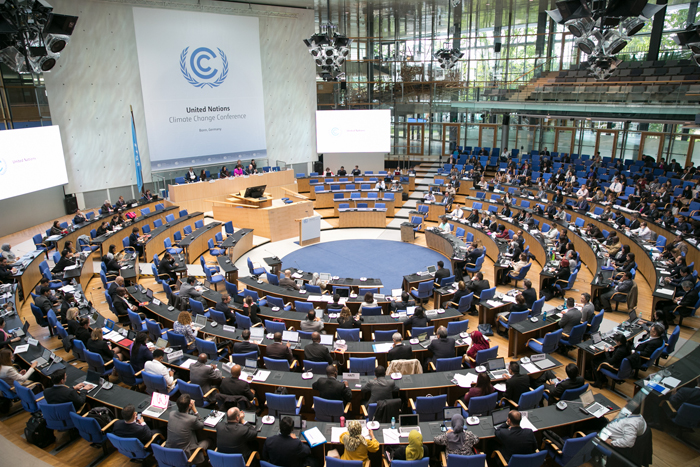The US withdrawal from climate and environmental leadership sets an appalling example, but Australia is doing nothing to counter it.

Delegates gather in the main hall at Bonn for this year’s UNFCCC climate summit. PHOTO Kiara Worth, IISD/ENB
Another year, another global climate summit. But this year’s event in Bonn, Germany, marks the start of a wholly new phase in the battle to contain climate change.
The United States – at least in a formal sense – is now completely alone in the world after Donald Trump announced in June that he was pulling his country out of the landmark Paris Agreement. Every other nation has now signed up.
At the time of the announcement, a US Gallup Poll showed 84 per cent of citizens were concerned about climate change, 68 per cent believed it was caused by humans and 62 per cent thought it was already happening. That was before the country’s calamitous autumn hurricanes and wildfires.
Trump’s decision came in a year that, even without a warming El Nino event, is all but certain to join 2015 and 2016 as the hottest years on record. And data released yesterday show that after remaining flat for two years, global emissions this year are at an all-time high.
Pointing out that national commitments underpinning Paris fall far short of what is needed to avoid dangerous warming, the UN’s annual Emissions Gap Report to the Bonn meeting called for accelerated short-term action and greater longer-term national ambition.
The report stressed that “avoiding building new coal-fired power plants and phasing out existing ones is crucial to closing the emissions gap”. That is, being serious about climate change means no more coal.
Extractive industry has a special pull on many national governments, including our own. The global Extractive Industries Transparency Initiative (EITI) seeks full disclosure of government-miner financial transactions. Australia says it supports that idea, but has yet to implement it.
Last week Trump withdrew from EITI, claiming it was out of step with the US legal framework. But the truth is that he took the side of US mining interests including the American Petroleum Institute, which don’t want to see secret and corrupt practices exposed.
Step by step, while dismantling long-standing environmental protections at home, Trump is weakening international instruments and measures solely to protect the profits of private US corporations, notably coal, oil and gas interests.
The US will not formally leave the Paris agreement until 2020, but its official delegation in Bonn, thanks to Trump, is without influence and authority – more an observer than a participant.
The gap left by the US pull-out is being partly filled by an expanded Chinese presence, with an expectation that the country will take the opportunity to announce a 2018 start to its long-anticipated national carbon trading scheme.
Others are stepping up. In Montreal a month out from the Bonn summit, ministers from the European Union and Canada joined China to declare their commitment to the “full and swift implementation” of the Paris Agreement.
The “We Are Still In” coalition is an unofficial delegation of US governors, mayors and business leaders. Their stall at Bonn – the meeting’s largest – declared to the world that the American people remained firmly behind the Paris Agreement.
You don’t have to be a big player to be a leader. New Zealand’s climate change minister, James Shaw, is putting the case in Bonn for people displaced by climate change to be recognised globally as refugees, while domestically he’s looking at a new climate refugee visa category.
Shaw’s ideas will have support among island nations and their advocates in Bonn, but probably not from Australia, where the refugee issue has become conflated with border protection.
But the issue of climate refugees is becoming more pressing with each passing year. Pacific island populations are relatively small, but a recent Cornell University (US) study found that worldwide we could be looking at over a billion people displaced by rising seas by mid-century and double that number by 2100. If any climate issue calls for leadership and vision, this is it.
The Trump administration’s withdrawal from Paris and EITI and its dismantling of domestic environmental instruments and measures set an appalling example for the world. But our own example leaves a lot to be desired.
For four years now, Australia has been virtually absent from the global climate debate. Our government’s grossly inadequate 2030 target (a 26-28 per cent cut below 2005 levels) and its advocacy of more coal-fired electricity stands directly opposed to global aspirations in Bonn.
With the US out of the picture, other countries including Australia are being asked to step up and show some leadership. That would require us to strengthen our 2030 emissions target, set even stronger long-term targets, abandon plans to revive coal power, and fully implement EITI.
We have done none of these things, while advocating and pursuing domestic policies that undermine Paris goals. We are starting to look like Trump’s patsy. Is that really what we want?
